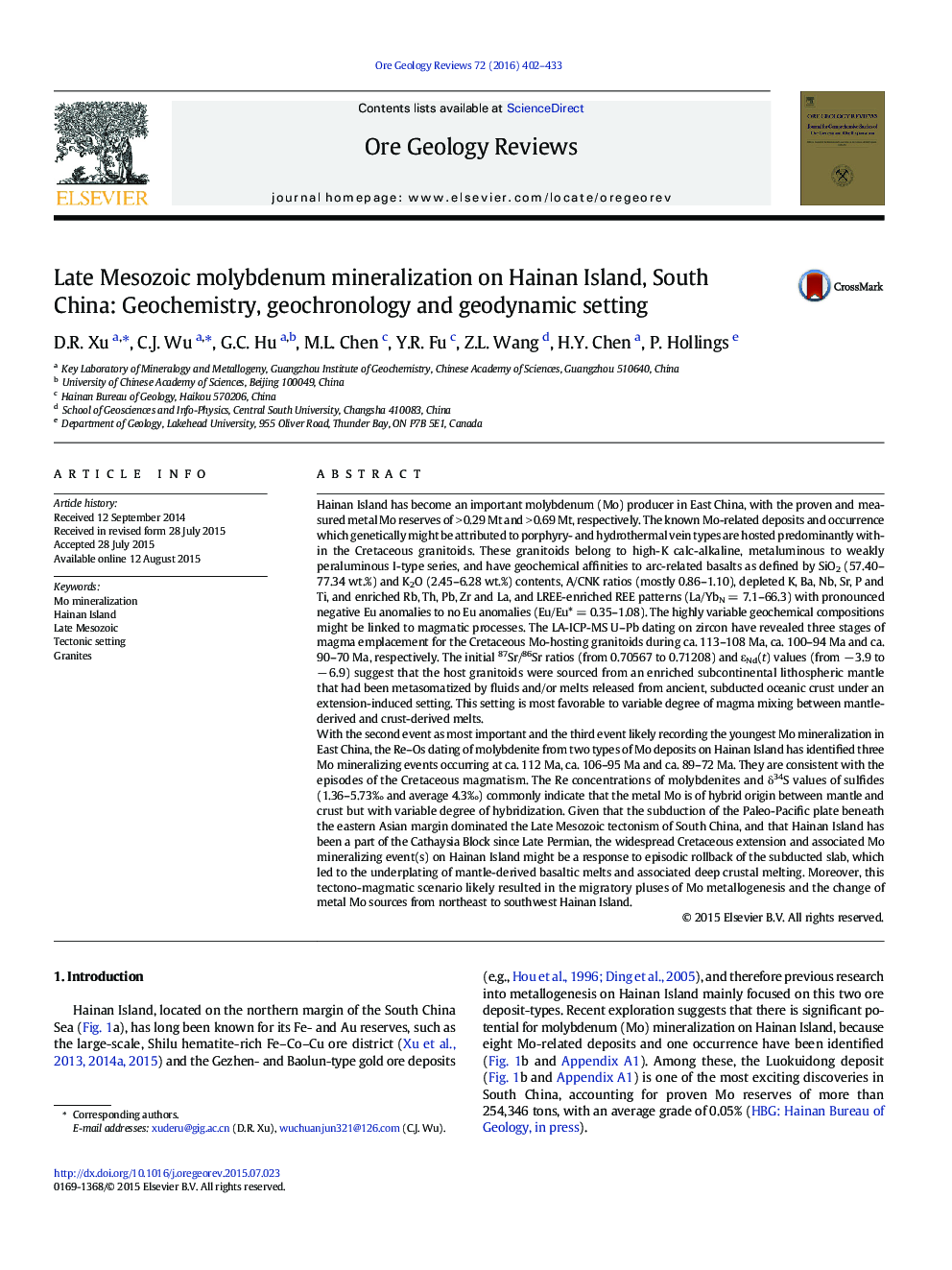| کد مقاله | کد نشریه | سال انتشار | مقاله انگلیسی | نسخه تمام متن |
|---|---|---|---|---|
| 6435755 | 1351852 | 2016 | 32 صفحه PDF | دانلود رایگان |
- Host rocks predominantly are the Cretaceous high-K calc-alkaline, I-type granitoids.
- Three epochs of Mo mineralization during the Cretaceous have been recognized.
- Ca. 106-95Â Ma epoch produced most of the metal Mo resources.
- Ca. 89-72Â Ma epoch likely recorded the youngest Mo mineralizing event in East China.
- Mo mineralization might follow episodic slab-rollback of the paleo-Pacific plate.
Hainan Island has become an important molybdenum (Mo) producer in East China, with the proven and measured metal Mo reserves of > 0.29 Mt and > 0.69 Mt, respectively. The known Mo-related deposits and occurrence which genetically might be attributed to porphyry- and hydrothermal vein types are hosted predominantly within the Cretaceous granitoids. These granitoids belong to high-K calc-alkaline, metaluminous to weakly peraluminous I-type series, and have geochemical affinities to arc-related basalts as defined by SiO2 (57.40-77.34 wt.%) and K2O (2.45-6.28 wt.%) contents, A/CNK ratios (mostly 0.86-1.10), depleted K, Ba, Nb, Sr, P and Ti, and enriched Rb, Th, Pb, Zr and La, and LREE-enriched REE patterns (La/YbN = 7.1-66.3) with pronounced negative Eu anomalies to no Eu anomalies (Eu/Eu* = 0.35-1.08). The highly variable geochemical compositions might be linked to magmatic processes. The LA-ICP-MS U-Pb dating on zircon have revealed three stages of magma emplacement for the Cretaceous Mo-hosting granitoids during ca. 113-108 Ma, ca. 100-94 Ma and ca. 90-70 Ma, respectively. The initial 87Sr/86Sr ratios (from 0.70567 to 0.71208) and ÉNd(t) values (from â 3.9 to â 6.9) suggest that the host granitoids were sourced from an enriched subcontinental lithospheric mantle that had been metasomatized by fluids and/or melts released from ancient, subducted oceanic crust under an extension-induced setting. This setting is most favorable to variable degree of magma mixing between mantle-derived and crust-derived melts.With the second event as most important and the third event likely recording the youngest Mo mineralization in East China, the Re-Os dating of molybdenite from two types of Mo deposits on Hainan Island has identified three Mo mineralizing events occurring at ca. 112 Ma, ca. 106-95 Ma and ca. 89-72 Ma. They are consistent with the episodes of the Cretaceous magmatism. The Re concentrations of molybdenites and δ34S values of sulfides (1.36-5.73â° and average 4.3â°) commonly indicate that the metal Mo is of hybrid origin between mantle and crust but with variable degree of hybridization. Given that the subduction of the Paleo-Pacific plate beneath the eastern Asian margin dominated the Late Mesozoic tectonism of South China, and that Hainan Island has been a part of the Cathaysia Block since Late Permian, the widespread Cretaceous extension and associated Mo mineralizing event(s) on Hainan Island might be a response to episodic rollback of the subducted slab, which led to the underplating of mantle-derived basaltic melts and associated deep crustal melting. Moreover, this tectono-magmatic scenario likely resulted in the migratory pluses of Mo metallogenesis and the change of metal Mo sources from northeast to southwest Hainan Island.
Journal: Ore Geology Reviews - Volume 72, Part 1, January 2016, Pages 402-433
